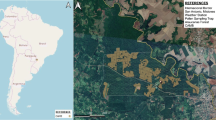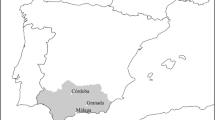Summary
7 years of airborne pollen monitoring in Perugia (central Italy) were used to determine the temperature requirements to break dormancy and to resume growth and bloom ofCorylus avellana L.,Corylus needs 1000 chill-units to complete its dormancy and this value, in the Perugian area, is met by the end of December or the first days of January. MoreoverCorylus trees require 220 growth degree hours before they are able to flower. If air temperature is high, this value can be achieved in only 10 days, but if the temperature remains too low, the heat accumulation can require up to 35 days. With these parameters it is possible to build a model to predict the date of the beginning ofCorylus avellana pollen season.
Similar content being viewed by others
References
Ashcroft G.L., Richardson E.A., Seeley S.D., (1977) —A statistical method of determining chill unit and growing degree hour requirements for deciduous fruit trees. Hort. Science,12:347–348.
Faust M., (1989) —Physiology of temperate zone fruit trees. John Wiley & Sons, New York: 188–199.
Frenguelli G., Romano B., Mincigrucci G., Paola G., Bricchi E., (1981) —Calendario pollinico di Ascoli Piceno. I. Anno 1981. Ann. Fac. Agraria, Università di Perugia,35:389–402.
Guerriero R., Cipriani G., Giovannini D., Pitacco A., (1990) —Flowering and bud break of peach cv. «Springcrest» grown at three different latitudes. XXXIII International Horticultural Congress, Firenze: 4329.
Kramer P.J., Kozlowski T.T., (1979) —Physiology of woody plants. Academic Press New York: 546–627.
Linvill D.E., (1990) —Calculating chilling hours and chill units from daily maximum and minimum temperature observations. Hort. Science,25:14–16.
Richardson E.A., Schuyler D.S., Walker D.R., (1974) —A model for estimating the completion of rest for «Redhaven» and «Elberta» peach trees. Hort. Science,9:331–332.
Rodriguez A., Sanchez-Tames R., (1986) —Dormancy and seasonal changes of plant regulators in hazel buds. Physiol. Plant.,66:288–292.
Wareing P.F., (1969) —Germination and dormancy. In: Physiology of plant growth and development, Ed. Wilkins M.B., McGraw-Hill, London: 605–640.
Wareing P.F., Phillips I.D.J., (1978) —The control of growth and differentiation in plants. 2nd ed., Pergamon Press, Oxford: 253–280.
Westwood M.N., (1978) —Temperate zone pomology. Freeman W.H. and Co. San Francisco: 300–303.
Wood B.W., (1983) —Changes in indolacetic acid, abscisic acid, gibberellins and cytokinins during budbreak in Pecan. J. Am. Soc. Hortic.,108:333–338.
Author information
Authors and Affiliations
Rights and permissions
About this article
Cite this article
Frenguelli, G., Bricchi, E., Romano, B. et al. The role of air temperature in determining dormancy release and flowering ofCorylus avellana L.. Aerobiologia 8, 415–418 (1992). https://doi.org/10.1007/BF02272908
Issue Date:
DOI: https://doi.org/10.1007/BF02272908




